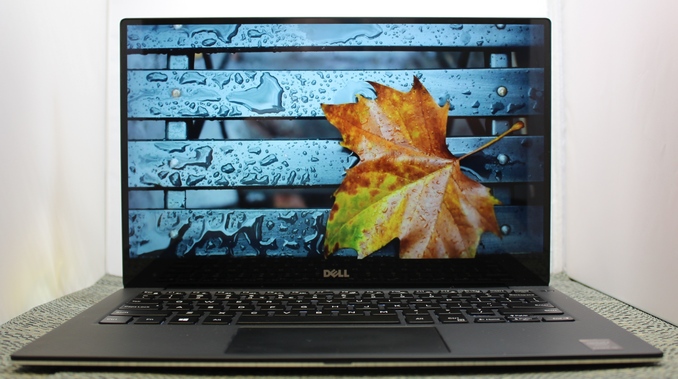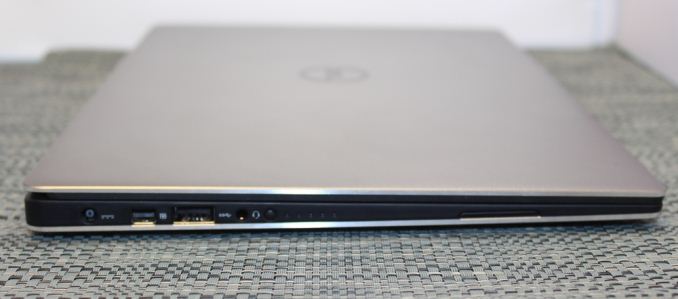Dell XPS 13 Review
by Brett Howse on February 19, 2015 9:00 AM EST- Posted in
- Laptops
- Dell
- Ultrabook
- Broadwell-U
- XPS 13

Dell launched the 2015 version of their XPS 13 at CES in January, and it made a big impression because of something that was very small. The first thing you see when you look at the XPS 13 is how small the bezels are around the display. At 5.2 mm, they are easily the thinnest display bezels on any laptop made today. Dell claims the XPS 13 is a 13 inch display in the chassis of an 11 inch notebook, and while they have made that claim before, for 2015, it would be hard to argue with them. But the XPS 13 is more than just a display, and Dell has outfitted it with some very modern hardware to give us our first look at an Ultrabook based on the just launched Intel 5th Generation processors, Broadwell-U.
At CES, Dell also told me that the new XPS 13 would have great battery life, with the company claiming that it would get up to fifteen hours. That claim seems hard to believe, with our battery life test topped at just a hair under ten hours by the current leader, the MacBook Air 13. However, this will be our first look at a laptop running on the new 14 nm process from Intel, so we can get a chance to see just how power efficient the new processors are.
Dell is offering quite an arrangement of options as well, allowing the new XPS 13 to fit into a lot more budgets than some of the other premium notebooks around. The base model comes with the Intel Core i3-5010U processor, but if you need more speed you can upgrade to the i5-5200U or i7-5500U. All of the storage options are solid state drives, which is great to see. The base is 128GB, and optional upgrades are to 256GB or 512GB. Memory choices are dual-channel 4GB DDR3L-RS-1600, or a dual-channel 8GB option.
We received two models for testing, with the first being a Core i5-5200U with the 1920x1080 non-touch display, 4GB of memory, and a 128GB SSD, which lists for $900. The second model is the Core i5-5200U, with 2x4GB of memory, a 256GB SSD, and the 3200x1800 touch display. This model lists at $1400.
Update: Originally I had listed the 4 GB model as single channel, but it is actually 2 x 2 GB for dual channel. Sorry for the mistake.
| Dell XPS 13 9343 Specifications | |
| Processor | Intel Core i3-5010U (Dual-core + HT 2.1GHz 3MB L3 14nm 15W TDP) Intel Core i5-5200U - model tested (Dual-core + HT 2.2-2.7GHz 3MB L3 14nm 15W TDP) Intel Core i7-5500U (Dual-core + HT 2.4-3.0GHz, 4MB L3, 14nm, 15W TDP) |
| Chipset | Broadwell-ULT |
| Memory | 2 x 2GB or 2 x 4GB DDR3L-RS-1600 (Dual Channel 8GB Max) |
| Graphics | Intel HD 5500 (23 EUs at 300-900MHz on Core i3) (24 EUs at 300-900MHz on Core i5) (24 EUs at 300-950MHz on Core i7) |
| Display | 13.3" Anti-Glare IPS 16:9 FHD (1920x1080) (Sharp 1420 Panel) 13.3" Glossy IPS 16:9 QHD+ (3200x1800) IGZO2 (Sharp 1421 Panel with Corning Gorilla Glass NBT and Touchscreen) |
| Storage | 128GB/256GB/512GB SSD (Samsung PM851 M.2 2280) |
| Optical Drive | N/A |
| Networking | Dell Wireless 1560 plus Bluetooth 4.0 - model tested (2x2:2 802.11ac 867Mbps capable Broadcom) Intel Dual Band Wireless-AC 7265 plus Bluetooth 4.0 (2x2:2 802.11ac 867Mbps capable) Intel Dual Band Wireless-N 7265 plus Bluetooth 4.0 (2x2:2 802.11n 300Mbps capable) |
| Audio | Realtek HD Stereo Speakers professionally tuned with Waves MaxxAudio Pro 1w x 2 Headset jack |
| Battery/Power | 52Wh non-removable 45W Max AC Adapter |
| Front Side | Charge Light |
| Left Side | Headset Jack Battery Meter 1 x USB 3.0 with PowerShare 1 x mini DisplayPort Speaker AC Power Connection |
| Right Side | Noble Lock Slot 1 x USB 3.0 with PowerShare SD Card Slot Speaker |
| Back Side | N/A |
| Operating System | Windows 8.1 64-bit |
| Dimensions | 11.98" x 7.88" x 0.33-0.6" (WxDxH) (304mm x 200mm x 9-15mm) |
| Weight | 2.6 lbs (1.18kg) Non-Touch 2.8 lbs (1.27kg) Touch |
| Extras | 720p HD Webcam Backlit Keyboard |
| Colors | Silver |
| Pricing | $800 (i3, 4GB, 128GB, FHD) $900 (i5, 4GB, 128GB, FHD) - model tested $1000 (i5, 8GB, 128GB, FHD) $1300 (i5, 8GB 128GB, QHD+) $1400 (i5, 8GB, 256GB, QHD+) - model tested $1600 (i7, 8GB, 256GB, QHD+) $1900 (i7, 8GB, 512GB, QHD+) |
The display has some choices as well. The base model comes with a 13.3 inch 1920x1080 IPS display, with a matte finish, and no touch capabilities. This is still a respectable 165 pixels per inch, and is a good option to keep the costs down. The upgraded display is quite the upgrade. Dell has worked with Sharp to outfit the XPS 13 with an optional 3200x1800 resolution IGZO panel, which features Corning Gorilla Glass NBT over the top, along with ten-point multitouch. This works out to 272 pixels per inch, and the IGZO panel is a full RGB stripe.
There are a couple of other options as well, such as a range of wireless adapters, with the Dell 1560 outfitted on the review laptops that we received. This is a Broadcom wireless adapter, with 802.11ac support. Some of the options, like the 512GB drive, are only available with the top CPU and upgraded display. Dell does offer some degree of flexibility when ordering, but not all options are available for all devices.
Dell has crafted a fine looking laptop, with some new parts from Intel and Sharp paving the way. On paper this is a great start, so let's get into the finer details.











201 Comments
View All Comments
DanNeely - Thursday, February 19, 2015 - link
Have Dell/Sharp ever explained what is so special about the new display to get the bezels that small? They hyped it up as a Dell exclusive when first announced; but looking at it the first thing to come to mind is "smartphones have had bezels that small for a while; what's so special about making a laptop size screen the same way."PS No web cam fail picture? The one from Ars Technica's review was great.
http://cdn.arstechnica.net/wp-content/uploads/2015...
retrospooty - Thursday, February 19, 2015 - link
The question is, "why haven't other been doing this all along"... Or at least making an effort towards smaller bezels in general.jabber - Friday, February 20, 2015 - link
Just watch the flex as you open with a glass screen and bezels that thin."Ahh another fine morning, let's open up my lovely laptop and start work!"
'CRACK'
"Damn!"
retrospooty - Friday, February 20, 2015 - link
Its not going to crack when you open it... Dropping it may be a bigger worry than with other laptops, but not normal day to day usage.sorten - Friday, February 20, 2015 - link
jabber, you're expending a lot of energy to warn people about cracked screens.jabber - Friday, February 20, 2015 - link
Yes cos I've had quite a few come into me to fix. Didn't happen before screens had a glass touch layer on them.Well fancy that!
Not as robust as you would think. I'll take the non-touch option thanks.
fokka - Saturday, February 21, 2015 - link
sure, phone screens also were more robust when they were made out of plastic. the good thing is a laptop is closed when transporting it and since you're not just holding your laptop in one hand, chances it is dropped are also much smaller.glass on the other hand feels much nicer on touchscreens, imho it's much easier to clean and it can even make the screen lid more rigid.
i think panicing over broken laptop screens is a slight over reaction, but to each their own.
asliarun - Thursday, February 19, 2015 - link
As I understand it, the bezel is where the control circuitry (among other things like edge lighting) exists. IGZO or Indium Gallium Zinc Oxide transistors are transparent compared to amorphous silicon. Plus, they have significantly more electron mobility. All this combined means that the control circuitry can be etched on the panel itself instead of the bezel. Plus, the transparency and increased electron mobility allows them to make really high res displays that also consume less power.They even have prototypes of non-rectangular IGZO displays (such as truly circular displays).
But all this is based on reading a few articles, so feel free to correct me if I got something wrong.
kyuu - Monday, February 23, 2015 - link
It's not the IGZO tech that allows for the reduced bezels. This is evidenced by the fact that the 1080p non-IGZO option has the same sized bezels.Darkstone - Thursday, February 19, 2015 - link
It isn't special. It's just that nobody bothered to do it yet.I have an E6520, the bezels are around thumb-wide. But when i disassembly the display there is really only 3-4mm of metal to the side of the display. The rest of the space is air, an cable, and the solid magnesium frame. This laptop contains an completely standard display, an format that hasn't changed since.. a long time.
See https://www.youtube.com/watch?v=BSKZSjNuAr4 @ 4:00.
Of course that has it's advantages as well. If you drop your XPS 13 the display is progably more likely to break than a laptop with MBA-sized bezels. Mobile phones are more forgiving because there is less mass to begin with.